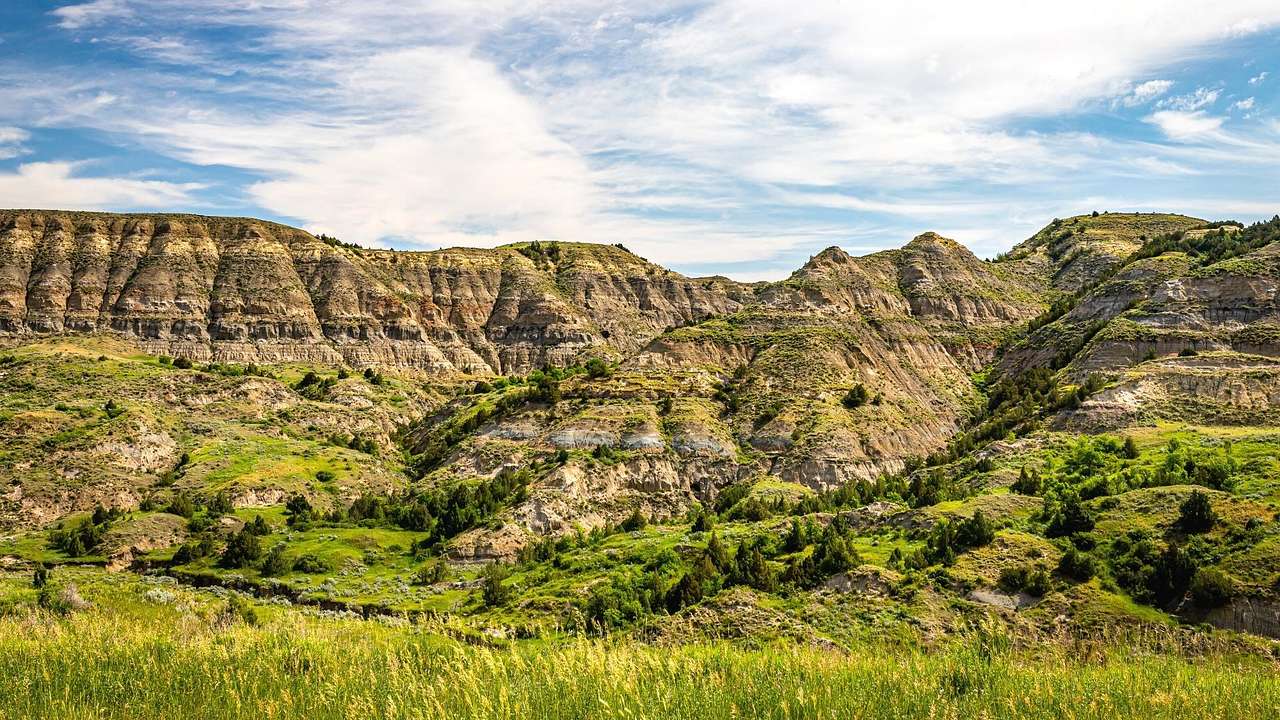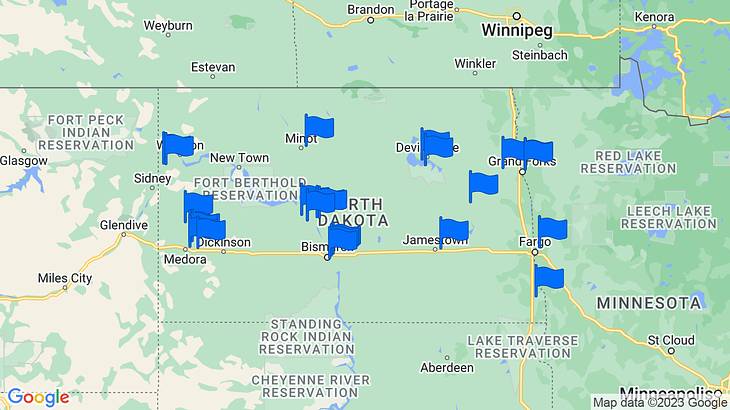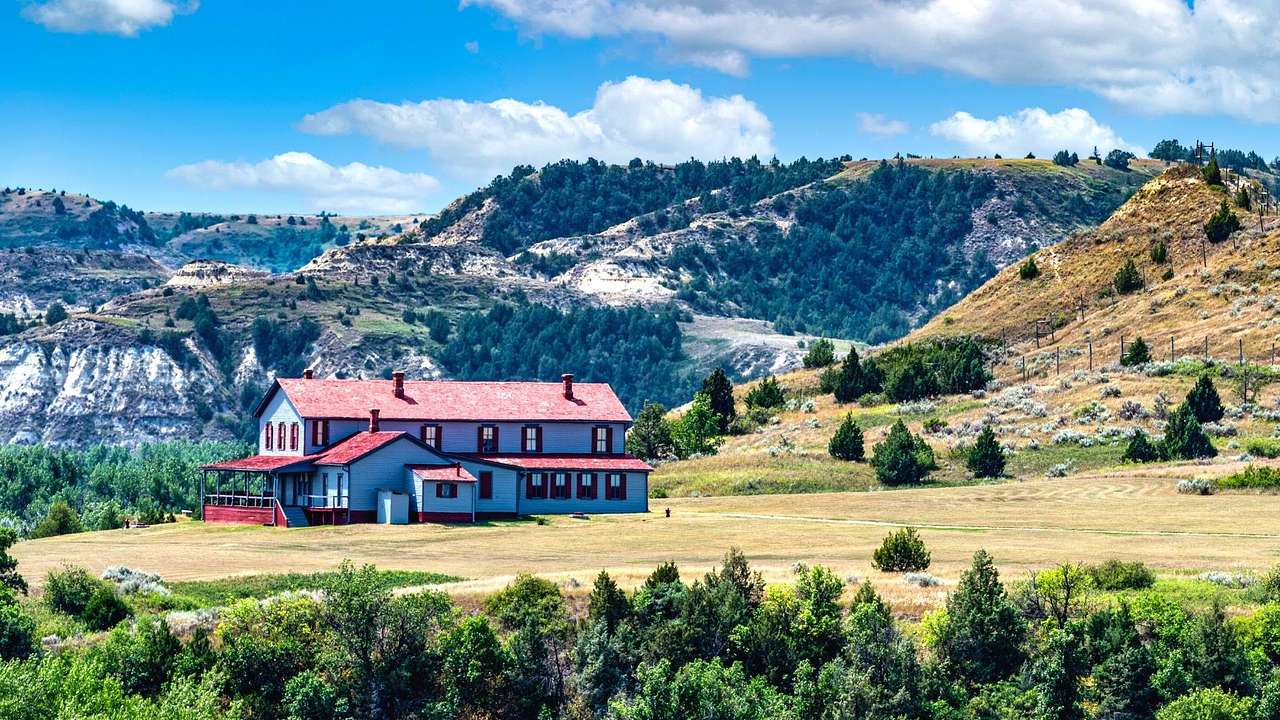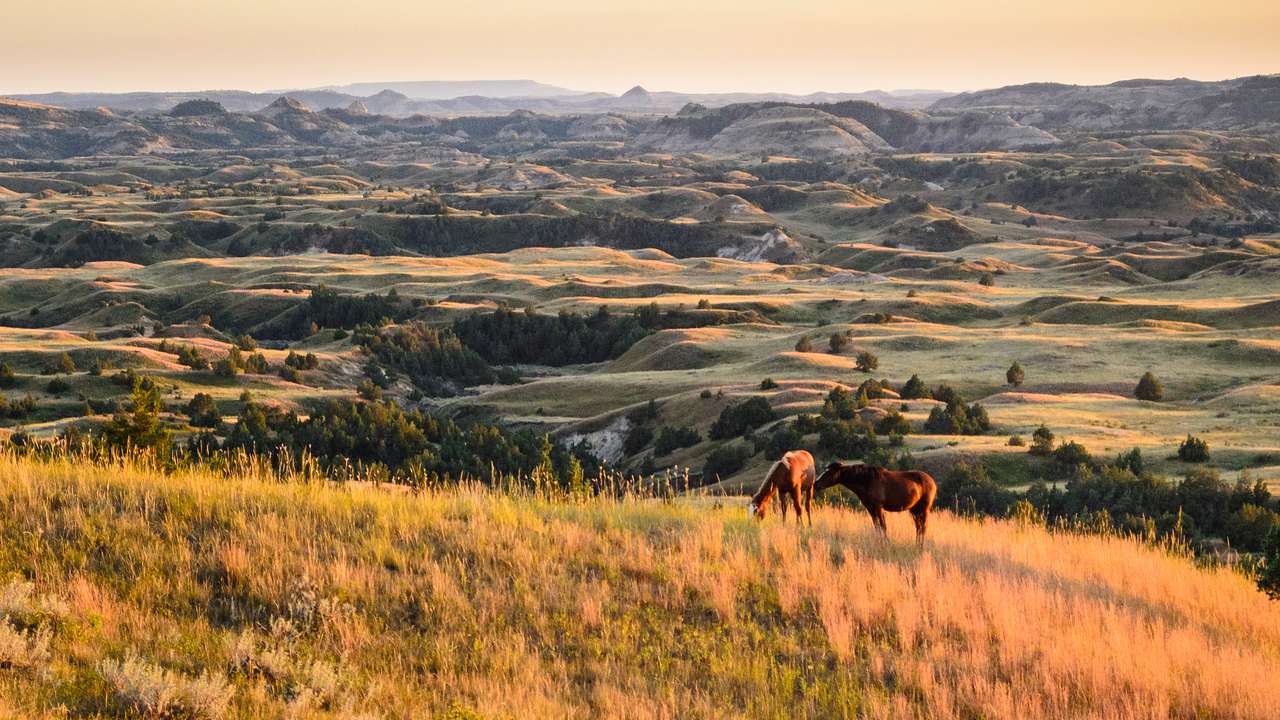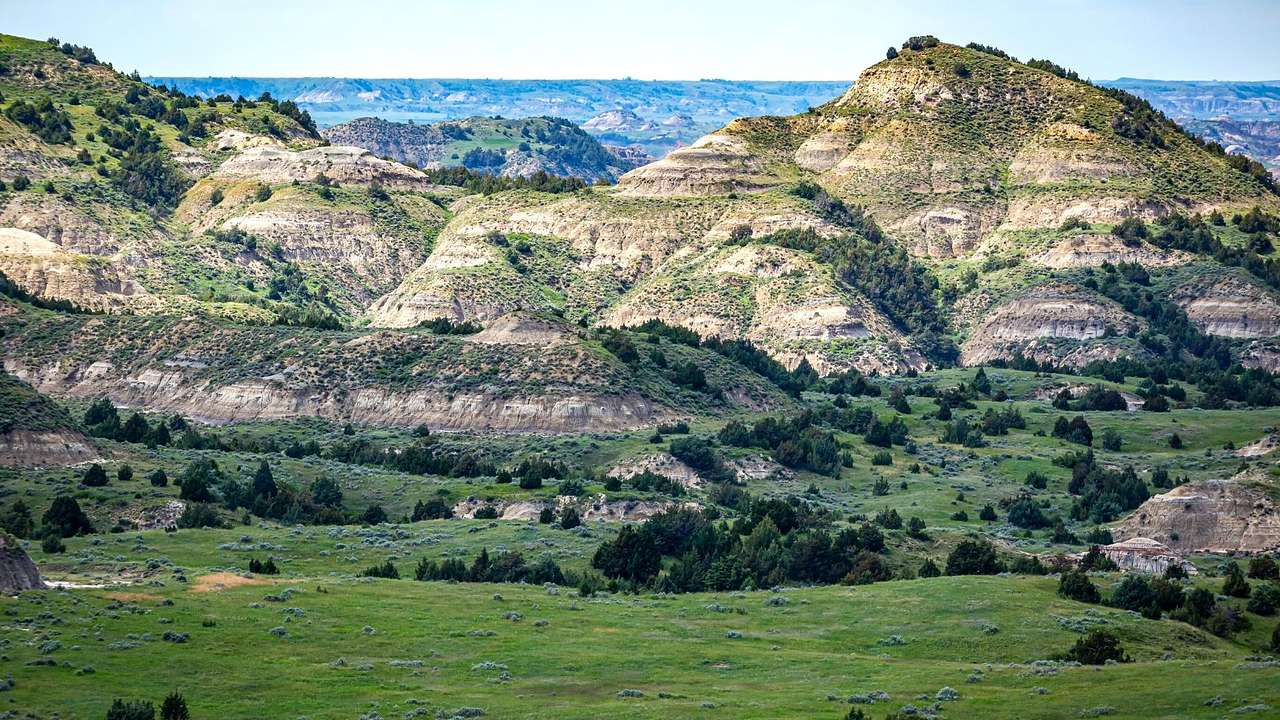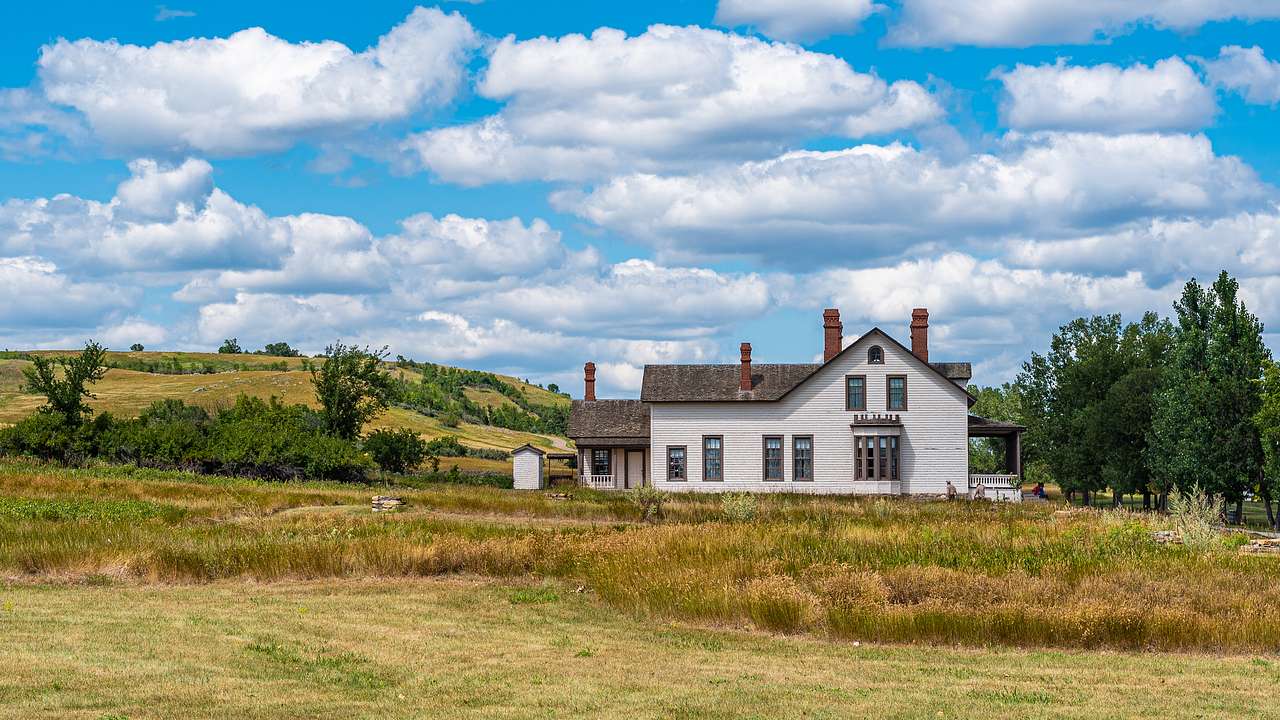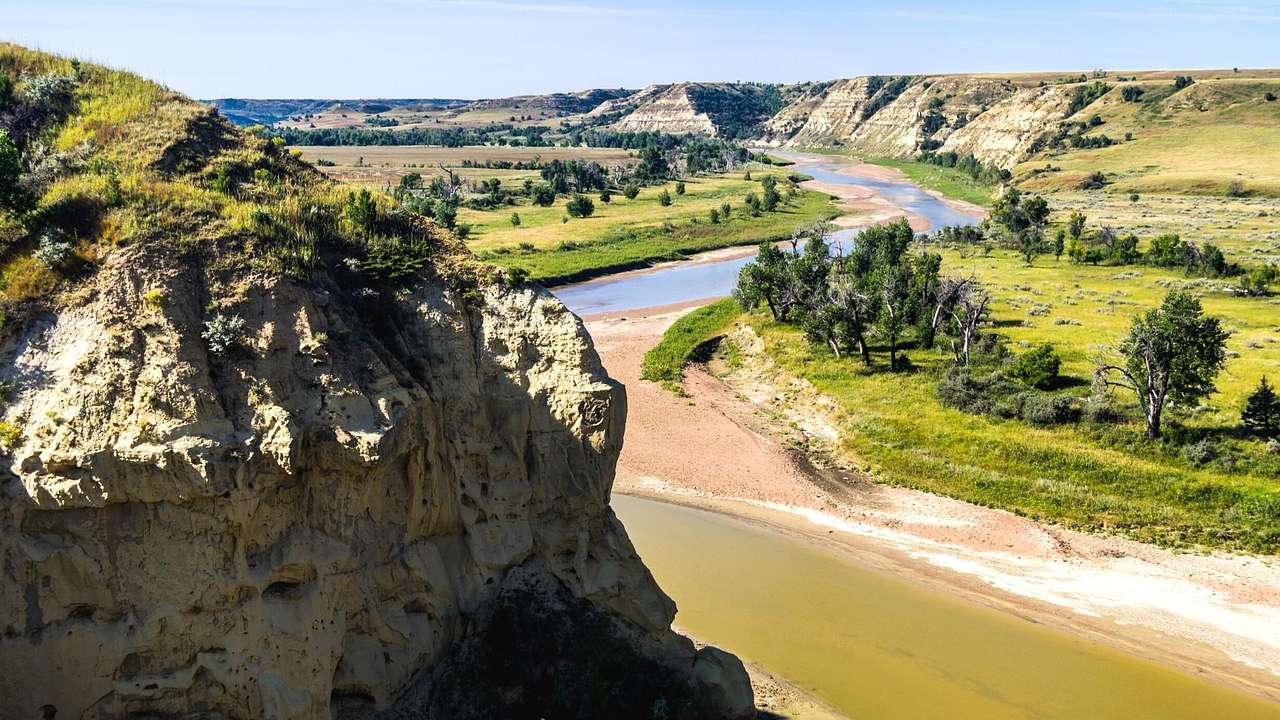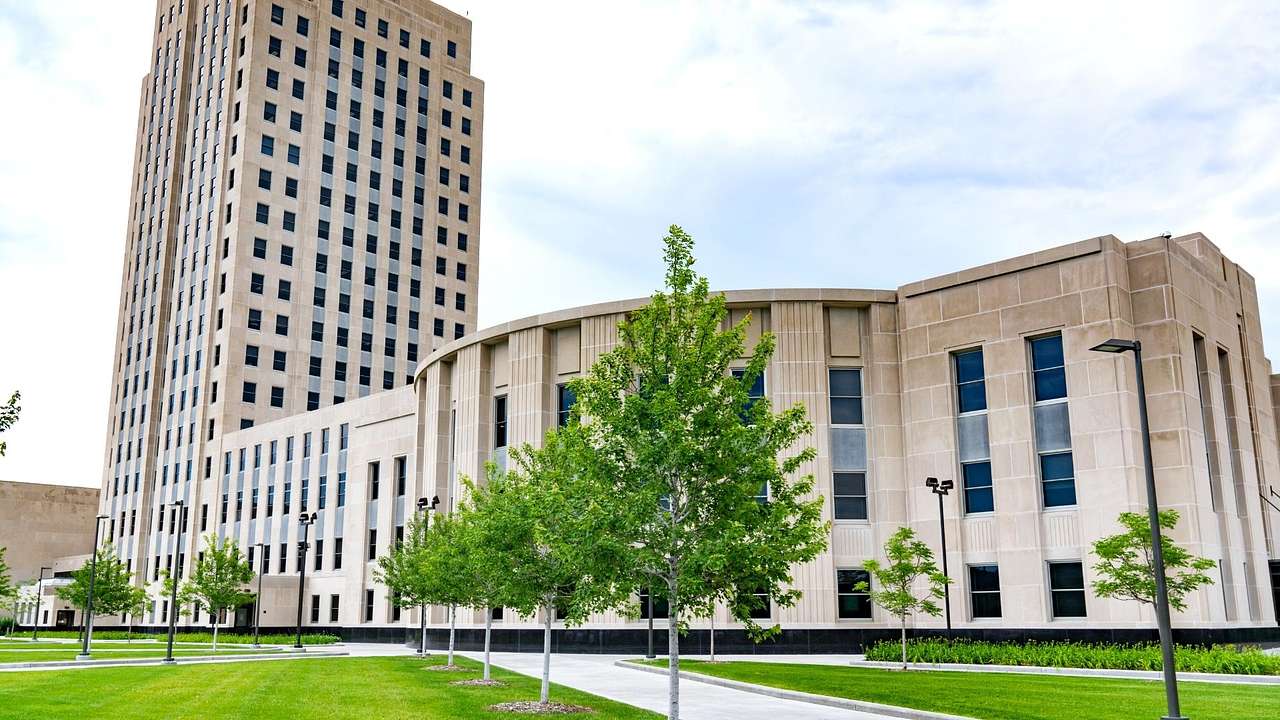25 Famous Landmarks in North Dakota Not to Miss
Destguides may receive commissions from purchases made through affiliate links in this article.
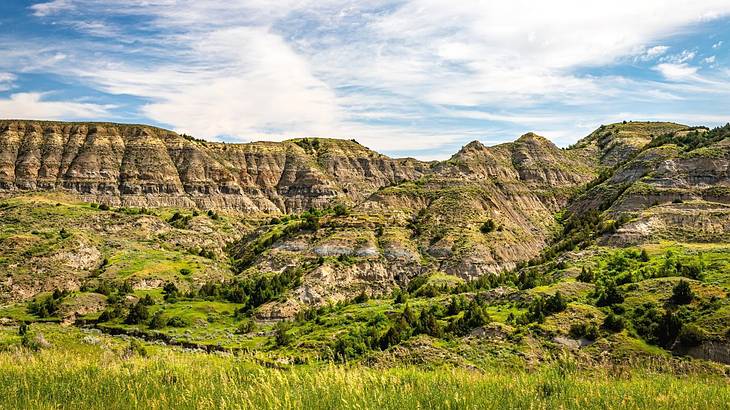
North Dakota is a less visited and less populated state in the northern part of the United States. Many people are unfamiliar with the state and its history. So you may be asking, "What is North Dakota famous for?"
North Dakota is famous for its historical sites, which were influential during the expansion of the United States to the West. Many museums in North Dakota also highlight bison, art, state history, and more.
The state has a lot of great places to visit if you like being active outside. At the state and national parks, you can hike, bike, camp, fish, and spend time out on a lake or river. The state parks also have some educational but fun exhibits and programs.
This article lists the 25 most famous landmarks in North Dakota that everyone will enjoy visiting. When you visit the Roughrider State, you can't miss these landmarks!
25 North Dakota Landmarks
- Bagg Bonanza Farm Historic Site
- Chateau de Mores State Historic Site
- Dakota Zoo
- Theodore Roosevelt National Park
- Elkhorn Ranch Unit
- Painted Canyon Overlook
- Fargo Air Museum
- Fort Abraham Lincoln State Park
- Fort Buford State Historic Site
- Fort Clark State Historic Site
- Fort Mandan State Historic Site
- Fort Totten State Historic Site
- Fort Union Trading Post National Historic Site
- Grahams Island State Park
- Knife River Indian Villages National Historic Site
- Lewis & Clark National Historic Trail
- Little Missouri River
- National Buffalo Museum
- North Dakota Heritage Center & State Museum
- North Dakota Museum of Art
- North Dakota State Capitol
- Ronald Reagan Minuteman Missile State Historic Site
- Scandinavian Heritage Park
- Turtle River State Park
- University of North Dakota
North Dakota Landmarks Video
Check out our highlights video of North Dakota landmarks.
North Dakota Landmarks Map
A map of North Dakota landmarks. Use the map to explore all of the points of interest.
Bagg Bonanza Farm Historic Site
Bagg Bonanza Farm Historic Site is the site of an old Bonanza farm. Wheat was grown at Bonanza farms in the late 19th and early 20th centuries. Today the site is run as a museum by a nonprofit organization.
At the site, which is 15 acres, you can visit the 21-bedroom house, home to the Baggs family. Other buildings to explore include barns, sheds, and homes where the hired help slept.

Chateau de Mores State Historic Site
Another one of North Dakota's landmarks is the Chateau de Mores, home of Marquis de Mores, a late 19th Century Frenchman. He came to the US and started many successful business ventures, including the primary cattle farm.
The 1883 home sits on the Chateau de Mores State Historic Site, where Chimney Park and the de Mores Memorial Park are. You can tour the home, learn more about the de Mores' lives, and see the inside with most of the original furniture.
Dakota Zoo
The next of the state's monuments is the Dakota Zoo in Bismarck. The zoo opened in 1961 with less than 100 animals. Today, it is home to more than 600 animals of 125 species over 90 acres.
You can see the animals at the zoo, participate in educational events, and see shows highlighting the animals' skills. The zoo is open year-round, weather permitting. And, you can take a train ride around the zoo during your visit.
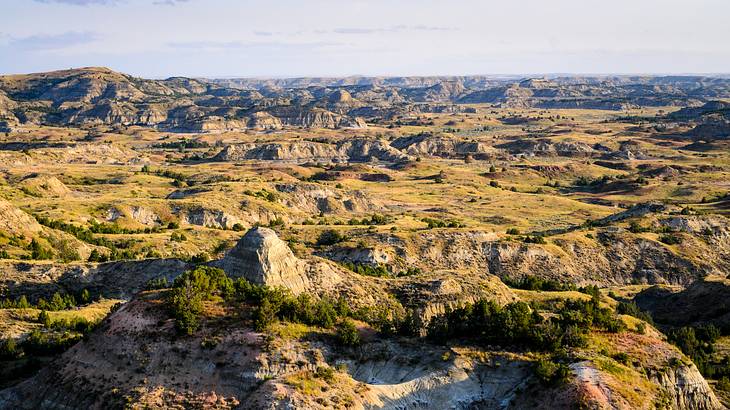
Theodore Roosevelt National Park
If you ask someone, "What is the most famous landmark in North Dakota?" They would likely say Theodore Roosevelt National Park.
Theodore Roosevelt National Park is another one of the famous places to visit in North Dakota. The area was a special place for former President Theodore Roosevelt, where he originally came to hunt bison.
Today, the park is one of the most visited places in the state. You can come here to camp, hike, spot wildlife, and understand why the land was an important place for President Roosevelt.
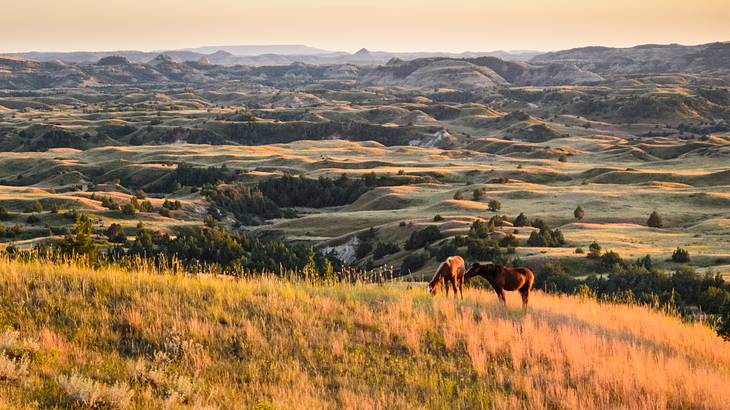
Elkhorn Ranch Unit
The Elkhorn Ranch Unit is part of the Theodore Roosevelt National Park. This area of the park is where Roosevelt called home towards the end of his life after his mom and wife passed.
At the cabin, there are exhibits with words written by Roosevelt about how he felt and spent his time at the ranch. And the drive to the cabin is quite scenic, although it is in a remote area of the park.

Painted Canyon Overlook
Another part of Theodore Roosevelt National Park is Painted Canyon Overlook. As soon as you arrive at the outlook, you will immediately see the canyons below. The best part of the overlook is that you can drive to it and not hike.
The area is also a visitors center with amenities and information about the site and the outlook. There is also staff to help you with questions about the park.
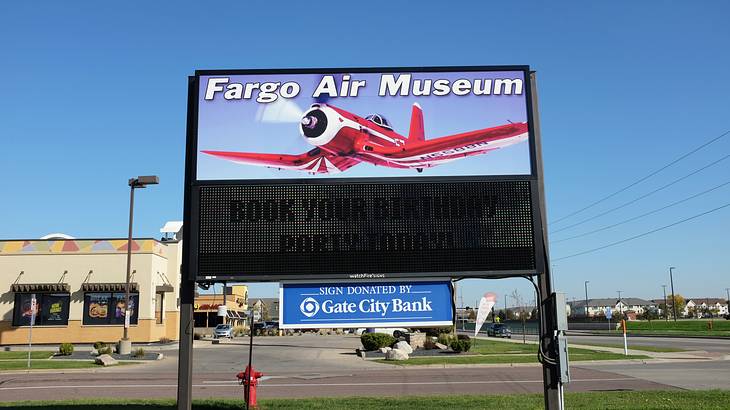
Fargo Air Museum
The Fargo Air Museum was started by a group of aviation enthusiasts, military personnel, pilots, and agriculturists. The nonprofit museum is relatively new, having opened in 2001.
The museum is home to many planes, some of which still fly today. There are also plenty of educational exhibits and events where you can learn about the history of aviation. There is also a recreation of the Flyer, the first plane built and flown by the Wright Brothers.
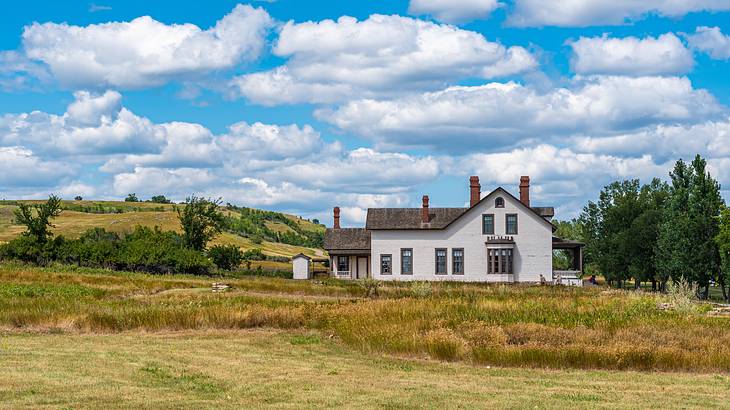
Fort Abraham Lincoln State Park
Fort Abraham Lincoln State Park is one of the natural landmarks in North Dakota. The park was home to Native Americans in earth lodges, which have been reconstructed for you to visit. The land was then converted into a military fort.
The state park is a great place to spend time outside camping, hiking, and going horseback riding. You can also tour the Custer House, where Lieutenant Colonel George Custer lived until he died in 1873.
Fort Buford State Historic Site
Another old military fort in North Dakota is the Fort Buford State Historic Site. The fort sits on the Missouri and Yellowstone Rivers, which made it a good site for the military. However, the site's primary purpose was to help and protect people settling to the west.
You can visit the site's original cemetery and the officer's quarters. The old quarters are now a museum where you can understand the site's history.
Fort Clark State Historic Site
Next is the Fort Clark State Historic Site, one of the state's archeological sites. Unfortunately, the site is well known for being home to deadly smallpox and cholera epidemics. It was also home to two fur trade posts that still sit on the site today.
You can visit the two fur trade posts or tour what remains of the Indian village. And, you will learn about the epidemics that devastated the site and how they affected its people.
Fort Mandan State Historic Site
Fort Mandan State Historic Site is where Lewis and Clark spent time in the fort during the winter of 1804 and 1805. Today you can explore a replica of the original fort or take a guided tour. There are also exhibits to learn about the winter Lewis and Clark spent here and what they discovered.
Fort Totten State Historic Site
Another military fort in North Dakota is Fort Totten State Historic Site. When the army fort closed in 1890, it opened as a school for American Indians.
You can see some of the original buildings at the site and learn about them in the educational exhibits. And, there are self-guided tours that let you experience life as one of the people who lived at the fort.
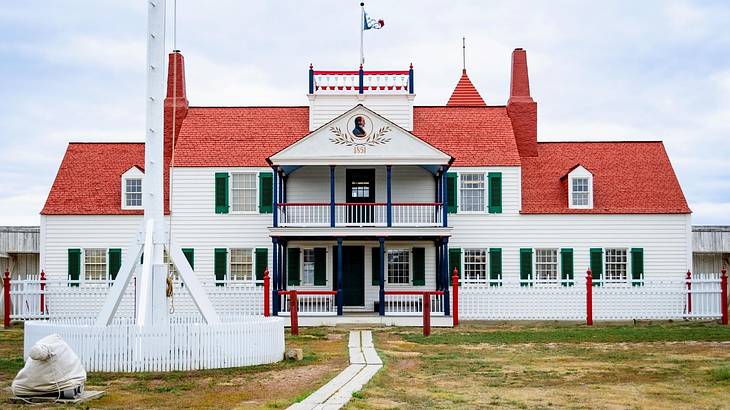
Fort Union Trading Post National Historic Site
The next one of the famous landmarks in North Dakota is Fort Union Trading Post National Historic Site. The fort was one of the most important posts for the fur trade on the Upper Missouri River from 1828 to 1867.
At the fur trading post, you can learn about the history of the site and the fur trade in the United States. There is also an Indian Arts Festival with art, music, and dancing.
A popular annual event at Fort Union today is the Fort Union Rendezvous. Re-enactors from across the United States and Canada come together to bring to life the traditional skills and way of life from the busy trade seasons of the past.
Grahams Island State Park
Grahams Island State Park is on Devils Lake. The island is one of the less visited landmarks in North Dakota. It hosts many fishing tournaments throughout the year. The island is an excellent place to visit year-round, and there are cabins for rent no matter when you are here.
The most popular activities on the island are fishing, camping, and hiking. You can also picnic, swim, boat on the lake, or ski and snowshoe in the winter.
Knife River Indian Villages National Historic Site
The Knife River Indian Villages National Historic Site was home to three Native American villages. People came to the area to trade and buy agricultural products that were grown in the area.
Today the historic site has a lot of educational exhibits and events. Some of the things you can learn about include Lewis and Clark, the Native Americans, and natural history. It is also a beautiful place to walk around.
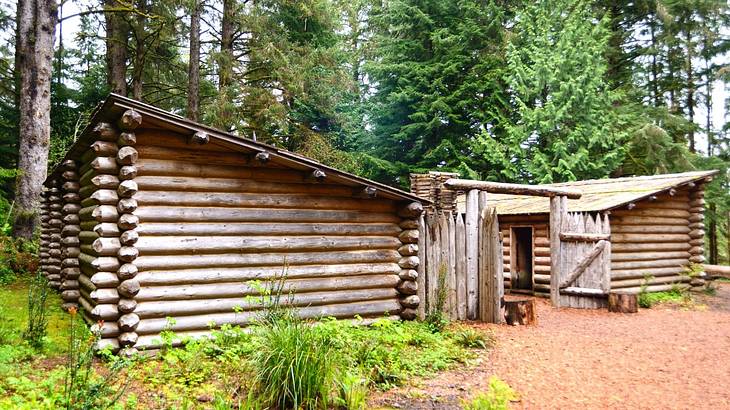
Lewis & Clark National Historic Trail
Part of the Lewis & Clark National Historic Trail is in North Dakota. The trail runs through 16 states. One of the places to discover new information about the trail and the story of the two explorers is the Lewis and Clark Interpretive Center. Stop by to learn about the expedition and the trail.
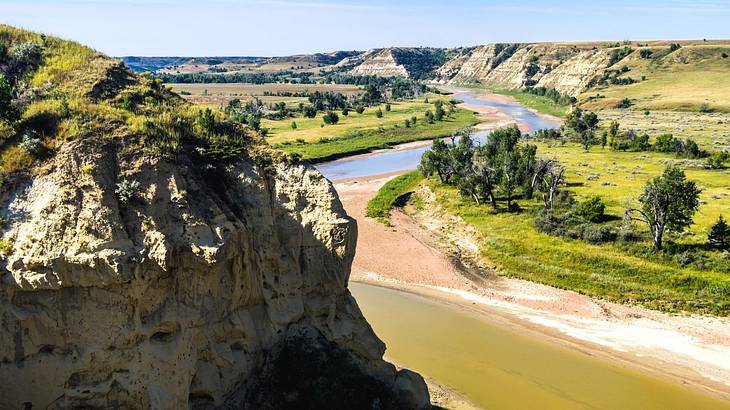
Little Missouri River
The Little Missouri River is a 560-mile-long river, part of which flows through North Dakota. The river flows north, and part runs through Theodore Roosevelt National Park.
You can hike near the river or in Little Missouri State Park. Or, you can hop on the river in a kayak or canoe and float. If you have the time and experience, you can spend multiple days floating on the river.
National Buffalo Museum
The National Buffalo Museum is the leading site in the United States, with everything you need to know about bison. Bison were an essential part of American history, and the museum is dedicated to teaching about them.
At the museum, you can learn about the history of bison and why they were so important in our history. The museum includes films, interactive exhibits, and guided tours to see a herd of bison.
North Dakota Heritage Center & State Museum
The North Dakota Heritage Center & State Museum is the largest museum in North Dakota. There are thousands of artifacts with stories to tell about the state.
You can explore four galleries at the museum to learn about the history of the state and its geographic formation. And the Arboretum Trail is a trail to hike on the museum grounds. The trail runs by the state Capitol building.
North Dakota Museum of Art
The North Dakota Museum of Art, or NDMOA, is a nationally recognized art museum. The NDMOA is the official art museum for the state, and it is on the University of North Dakota campus.
The museum has works from regional, national, and international artists throughout three galleries. There are also rotating exhibitions that feature different themes or artists. One of the most popular collections is the works of New York City art collector Barton Benes.

North Dakota State Capitol
One of the most famous sites in North Dakota is the North Dakota State Capitol building in Bismarck. The building is open for visitors, and sometimes there are public events.
You can tour the building to discover its history or walk the Capitol building and the grounds yourself. There are designated routes to walk on the capitol grounds. You can walk different length loops through parks and around the capital.
Ronald Reagan Minuteman Missile State Historic Site
Another one of the historical places in the state is the Ronald Reagan Minuteman Missile State Historic Site. The site was a missile alert and launch site during the Cold War.
You can take a guided tour of the site, and your tour guide will teach you about the people who lived at the site. You can also see the underground control center where the front lines of nuclear missile deterrence took place.
Scandinavian Heritage Park
The Scandinavian Heritage Park is a great place to learn about Scandinavian history and ancestry. Scandinavian heritage covers Denmark, Finland, Iceland, Norway, and Sweden., so anyone with those heritages should visit.
At the park is a full-scale replica of Norway's Stave Church. Another must-see attraction at the park is the 25-foot-tall Dala Horse of Sweden. And, there are lots of remembrances and other replicas from the countries.
Turtle River State Park
Turtle River State Park sits along the Turtle River, which is well-known for having a large trout population. The park was opened in the 1930s by a conservation group.
There are more than 12 miles to hike and bike along. Or, you can fish along the river or enjoy a picnic. Other activities include camping, skiing, and cross country skiing.
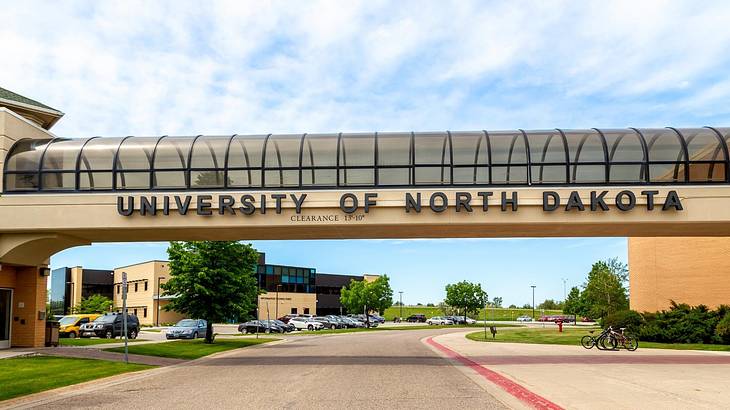
University of North Dakota
The final of the famous landmarks of North Dakota is the University of North Dakota (UND). The college is the oldest and most prominent in the state.
Of course, there are students and programs at the school. But, you can go there to see a show, participate in an educational event, or explore the beautiful campus.
Conclusion
North Dakota is an underrated state, and now you see that there is plenty to see and do when here. If you love history, nature, hiking, animals, or learning new things, you will have a lot of fun in North Dakota.
Make sure you visit all these 25 landmarks, which are the best in the state. You will learn a lot about the state's past and why North Dakota is so important in the country's history.
Give us feedback about this article
More visual stories related to this article:
Want to keep exploring?
Subscribe for discounts on tickets and hotels and our latest guides.
Thank you for subscribing
We will be in touch soon with discounts on tickets and hotels and our latest guides.
Want to keep exploring?
Subscribe for discounts on tickets and hotels and our latest guides.
Thank you for subscribing
We will be in touch soon with discounts on tickets and hotels and our latest guides.

